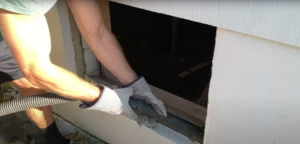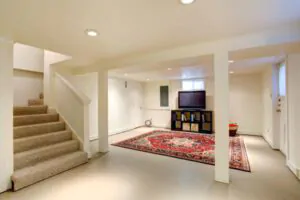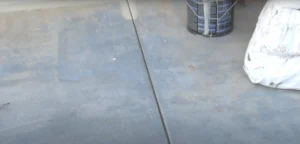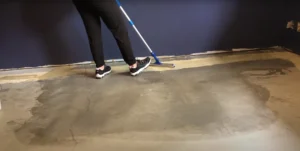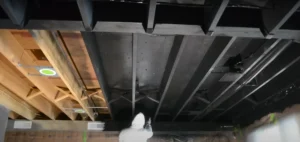Is your unfinished basement feeling more like a dark, cold storage space than a cozy part of your home? Many homeowners struggle with turning their basements into usable rooms without spending a fortune.
Moisture issues, old concrete floors, and plain walls can make the space feel uninviting and unusable.
How To Finish A Basement Inexpensively is easier than you think. This guide shares budget-friendly tips to transform your basement into a stunning living area. From affordable flooring options to simple wall and ceiling ideas, you’ll find everything you need to create a beautiful space without breaking the bank.
Ready to make your basement shine? Let’s get started!
Key Takeaways
- Start with Cleaning and Moisture Control: Declutter your basement and perform a moisture test to prevent mold. Waterproofing costs around $4,500 and is essential for a dry space.
- Choose Affordable Flooring Options: Use epoxy paint or floating floors like laminate or vinyl. These options are budget-friendly and easy to install yourself.
- Paint and Simple Wall Treatments: Painting walls with light, waterproof colors saves money and brightens the space. DIY wainscoting can also enhance walls without high costs.
- Budget-Friendly Ceiling Solutions: Opt for light paint or install drop ceilings. Drop ceilings are affordable, hide exposed joists, and allow flexible lighting.
- Plan and DIY to Save Costs: Basement remodeling typically costs between $3,000 and $35,000, averaging around $18,395. Doing tasks yourself can save 10-25% of your budget.
Initial Steps for Cost-Effective Basement Finishing
Start by decluttering your basement—it’s like a mini spring clean. Next, test for moisture to ensure your new space stays dry and cozy.
Clean out your basement
Clear out every nook and cranny. Remove old furniture, boxes, and any junk. Take out home mechanical systems carefully. This makes space for your diy basement project. Sorting items helps you see the true space available.
A clutter-free basement is easier to renovate on a budget.
A clean space is the first step to a stunning transformation.
Seal the block walls to prevent moisture. This stops mold and keeps your basement dry. Use waterproofing materials to protect your investment. A dry basement is vital for finished basement walls and flooring.
Start early to avoid costly repairs later.
Conduct a moisture test
Keep your basement dry and ditch the musty smells! Start with a moisture test using a meter on your walls and floors. Spot any damp spots, water stains, or that unmistakable moldy aroma? Time to act.
Seal cracks, install a sump pump, or lay down drain tiles. These budget-friendly waterproofing solutions protect your space and keep health risks at bay.
How Long Does It Take to Finish a Basement?
Finishing your basement usually takes four to eight weeks. Framing the walls takes about three to five days. Electrical and plumbing rough-ins each need three to five days. After that, a rough-in inspection takes one day.
Installing drywall takes around five days. Finally, laying the basement floor can be done in two to three days. Keeping your basement renovation on a budget is achievable with good planning.
Next, let’s look at budget-friendly flooring options.
Budget-Friendly Flooring Options
Updating your basement floor doesn’t have to be expensive. Choose affordable options like epoxy paint or floating floors to give your space a fresh new look.
Paint with epoxy
Epoxy paint is a smart choice for basement floors on a budget. It brightens your space and makes floors last longer. Apply epoxy to finish your basement DIY-style. This coating protects against moisture, perfect for concrete floors that might seep.
It’s easy to clean and comes in many colors. Epoxy improves the look and functionality of your basement without high costs.
Choosing epoxy paint saves money and enhances durability. It’s ideal for areas like laundry rooms or home offices. With epoxy, you get a strong, attractive floor that lasts. This budget-friendly option helps you achieve a stunning basement transformation easily.
Install a floating floor
Installing a floating floor is a smart way to upgrade your basement on a budget. These floors snap together without nails or glue, making them easy for a DIY project. Choose materials like laminate or vinyl that look like wood or tile.
Floating floors are durable and add value to your home without high costs.
Begin by measuring your basement to know how much flooring you need. Clean the concrete floor well and ensure it is dry. Lay down an underlayment to protect against moisture and add comfort.
Click the floating floor planks together, starting from one corner and working your way across the room. Finish by adding baseboards to cover the edges for a neat appearance. This method creates a beautiful living space without breaking the bank.
Economical Wall Finishing Tips
Choosing paint instead of drywall can significantly reduce your costs while brightening up your basement. Adding wainscoting yourself is another great way to enhance the space without spending a lot.
Use paint instead of drywall
Painting basement walls saves money and brightens the space. Choose light colors to make the area feel larger and more inviting. Waterproof paint stops moisture and protects against damage.
This method avoids the cost of drywall and materials like lumber or plywood. Painting also helps with insulation, keeping the basement warm and comfortable. It’s a simple DIY project that fits many budgets and improves your home’s real estate value.
Next, consider implementing DIY wainscoting.
Implement DIY wainscoting
Add DIY wainscoting to give your basement walls a fresh look without breaking the bank. Start by measuring the wall area you want to cover. Purchase affordable polyvinyl chloride panels and 2×4 studs from Home Depot, keeping the total cost around $460.
Cut the panels to fit your space and attach them securely to the studs using nails or screws. Once installed, paint the wainscoting with a primer and your favorite color to match your interior design.
This simple project enhances the appearance and helps insulate the walls, making your basement warmer and more comfortable. With basic tools and clear steps, you can achieve a stylish and functional upgrade on a budget.
How to Finish Concrete Basement Walls
To finish concrete basement walls on a budget, start by cleaning the area thoroughly. Remove any dirt and debris to prepare the surface. Next, conduct a moisture test by taping a plastic sheet to the wall for 24 hours.
If condensation appears, address the moisture issue before proceeding. Use a vapor barrier to prevent future moisture problems. This step is crucial to protect your new finishes and maintain a healthy environment.
Frame the walls using framing studs and secure them to the concrete with concrete blocks or anchors. Install insulation between the studs to keep the basement warm and improve energy efficiency.
Instead of drywall, consider painting the walls for a cost-effective and quick finish. Choose a waterproof primer first to ensure the paint adheres well and resists moisture. Adding simple shelving or hooks can enhance storage without extra costs, making your basement both functional and stylish.
Ceiling Solutions on a Budget
Upgrade your basement ceiling without emptying your wallet by choosing smart paint tricks or budget-friendly drop ceilings – find out more!
Opt for a simple paint job
Choose light colors to brighten your basement ceiling. Light shades reflect more light, making the space feel larger and more inviting. Painting is cheaper than installing drywall.
Use a good primer first for better coverage. This simple paint job saves money and time. Plus, it’s easy to do yourself. Add a fresh coat to transform your basement without breaking the bank.
Install drop ceilings
Drop ceilings are a smart choice for finishing your basement on a budget. They are fire-rated and offer soundproofing with fiberglass tiles. Installing a drop ceiling hides exposed ceiling joists and creates a clean look.
This simple option enhances safety and appearance without breaking the bank.
Lighting is easy to manage with drop ceilings. You can install or move light fixtures whenever you need. This flexibility helps you adjust the lighting to suit your space. Drop ceilings also keep the ceiling height intact, making your basement feel more open and bright.
Basement Finishing, Remodeling, and Renovation Insights
Transforming your basement doesn’t have to break the bank. Costs can range from $3,000 to $35,000, with an average remodel around $18,395. Waterproofing is essential and usually costs about $4,500.
Labor makes up 10-25% of your budget, so doing some DIY tasks, like installing carpet tiles or painting walls with primer, can save money. Homeowners often recover about 70% of their investment, making it a smart financial move.
A finished basement can add extra space for a home gym, bedroom, or home theater. Good insulation from remodeling helps lower energy costs by maintaining temperature. Choosing budget-friendly options like floating floors or drop ceilings keeps expenses down.
Ensuring your basement meets building code regulations is crucial. With smart choices, you can create a stunning, functional area without overspending.
Conclusion
Finishing your basement on a budget is totally doable. Simple ideas like painting and floating floors can save you money. Tackling projects yourself cuts costs even more. Enjoy your new space without emptying your wallet.
Start transforming your basement today!
FAQs
1. What are the first steps to start a DIY finished basement?
Begin by planning the layout. Check the concrete floor using a level to ensure it’s even. Install building insulation to keep the space warm. Frame the walls with top and bottom plates to the concrete floor. Make sure to use pressure-treated wood for areas near the water heater or any moisture sources.
2. How can I save money on basement flooring?
Choose a cost-effective kind of flooring like laminate or vinyl. These materials are affordable and easy to install yourself. Measure the square footage to buy the right amount. Use caulk around edges to prevent water damage and ensure durability.
3. What are some budget-friendly ideas for lighting in a basement?
Maximize daylighting by adding windows if possible. Use exposed ceiling lights or drop-ceiling fixtures to keep costs low. You can also install shelf lighting for storage areas. Painting the walls with primer can help make the space look brighter and more open.
4. How do I handle heating and ventilation on a budget?
Use existing heating systems and add portable heaters if needed. Ensure proper ventilation by installing vents or using fans. Insulate windows and doors to keep the space warm. Regularly maintain your heating and ventilation systems to save on energy costs.
5. What are affordable ways to add storage in a finished basement?
Install simple shelves for storage. Use closet organizers in any closet space. Build cabinetry with affordable materials to keep things tidy. Utilize wall space to store items without taking up floor space, making the basement feel larger.
6. How can I create a bathroom in my basement without high costs?
Choose a small bathroom design to save money. Use solid surface materials for countertops that are durable and inexpensive. Install a water-resistant floor to prevent damage. Keep plumbing simple by placing the bathroom near existing water lines to reduce construction costs.

